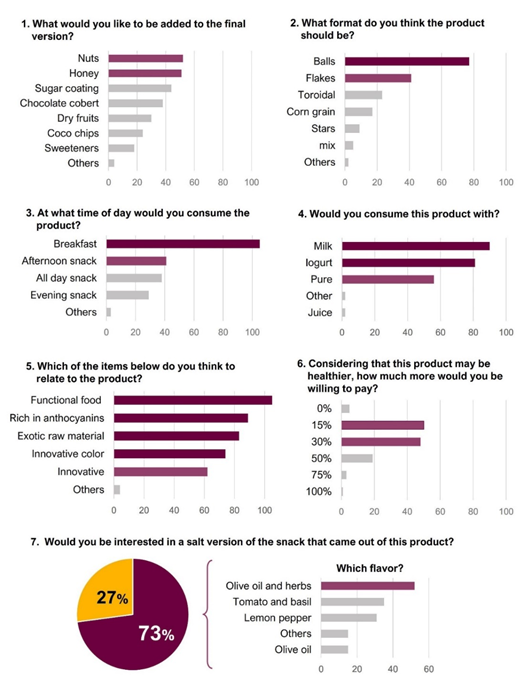1. Introduction
The growing consumer demand for quality, healthy, tasty, and attractive food has become a challenge for the food industry. Faced with this, the use of native or ethnic crops for the nutritional improvement of food products is a trend that is gaining popularity. According to Netzel et al. (2007) and Shelef et al. (2017), in addition to maintaining agro-diversity, native crops are seen as healthier, more sustainable, and have characteristics that make them special, such as color, flavor, and texture, thus generating products with new attributes. However, Samant et al. (2017) and Ting et al. (2016) point out that some consumers may not enjoy some of these attributes due to a lack of familiarity with those ingredients, especially if they are foreign. Therefore, it is always necessary to carry out acceptance studies and sensory profiles for good product development.
Purple maize (PM) (Zea mays L.) is a native crop of the Peruvian Andes characterized by intense purple grains. In that country, PM has been used since pre-Columbian civilizations as an ingredient that pro vides color, flavor, and texture in traditional drinks and desserts such as chicha and mazamorra morada (Alli Micuy, 2013; Vargas-Yana et al., 2020). PM has a high concentration of anthocyanins, flavonoids, and phenolic acids (Lao & Giusti, 2018; Pedreschi & Cisneros-Zevallos, 2007; Yang & Zhai, 2010), which can help to prevent and treat cardiovascular diseases (Petroni et al., 2017), obesity (Chaiittianan et al., 2017), diabetes (Zhang et al., 2019), and some types of cancer (Lao et al., 2017; Mazewski et al., 2017), then it is considered a functional food. Due to this earned fame, PM has become an emerging crop in Perú. According to the latest report from AGRODATA (2021), PM exportations increased 850% (6.7 thousand tons) in 2020 respect to 2019. However, PM exportation as a raw material still generates lower profits for producers and limits its application in developing new products.
Since 2006, Peru and Brazil have maintained a free trade agreement facilitating the exchange of products. Breakfast cereals have been one of the fastest-growing products in Brazil (24%) since the COVID-19 pandemic began. Brazilian consumers see breakfast cereals as a practical and healthier alternative to cookies and sweets (Euromonitor, 2021). However, there is suspicion about some of them due to the colorants, high sugar content, and low fiber amounts included in commercial brands, consequently, cereal manufacturers are searching for cleaner and healthier ingredients (Martini et al., 2021).
A large part of the breakfast cereals is made using commercial yellow corn grits (YCG) that allow obtaining expanded products with a texture accepted by consumers but poor in nutritional quality (Ai & Jane, 2016; Leusner, 2020). PM could be an alternative raw material to produce breakfast cereals. In previous studies, our team showed that purple maize whole flour (PMF) has a higher content of fiber (13%), essential amino acids, and minerals than commercial yellow corn (Salvador-Reyes et al. 2021). Likewise, when incorporated into the production of extruded cereals, PMF affects the physicochemical and techno-functional characteristics of the product, such as color, expansion, and instrumental texture due to the fibers and pigments present in its composition (Salvador-Reyes et al., 2023). Using a new ingredient such as PMF can change the perception and sensory acceptance of a product, then the study is essential to measure its commercial viability.
Descriptive sensory analyses with structured check-all-that-applied (CATA) questions enable more detailed information on sensory food properties. The CATA questions help determine which sensory attributes are desirable or undesirable in a sample and how much they influence the consumer's acceptance score (Ares & Jaeger, 2015). Then, the CATA test help develops new products. To date, sensory studies performed on extruded cereals formulated with pigmented maize have only evaluated the sensory acceptance of the products using a hedonic scale (Camire et al., 2002; Navarro-Cortez et al., 2018); therefore, the attributes and preferences of consumers concerning are still unknown.
Considering nutritional and technological advantages, as the opportunities of its use to develop products that meet the expectations and demands of the foreign market, PM could be a potential raw material to produce breakfast cereals with new sensory characteristics that need to be studied. In this sense, this study aimed to explore the perception and sensory acceptance of breakfast cereals made using PMF by Brazilian consumers through a CATA sensory analysis, complemented with a market research questionary.
2. Materials and methods
2.1. Sample preparation
For the present study, the same samples from our previous investigation (Salvador-Reyes, 2023) were used, where the characteristics of the raw materials and the physicochemical and functional properties of the extrudates are detailed. Four cereal samples were formulated using PMF and YCG in ratios of 100:0, 75:25, 50:50, and 25:75 (Figure 1). YCG was included since it is commercially used to produce breakfast cereals. The PMF was obtained from the grinding of PM grains imported from Peru (Chimbote-Ancash), while YCG was acquired in a Brazilian local market (Campinas-Sao Paulo).
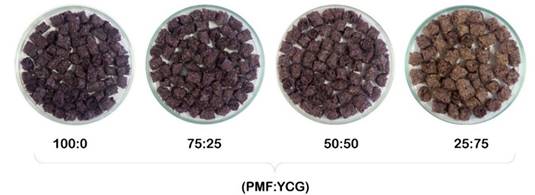
Figure 1 Sample breakfast cereals formulated with Peruvian purple maize flour (PMF) and yellow corn grits (YCG) in 100:0, 75:25, 50:50, and 25:75 ratios.
The extrudates were produced in a twin-screw extruder (ZSK 30 - Werner & Pfleiderer Corp (Ramsey, USA). Based on preliminary tests, the working parameters used were: die diameter (4.8 mm) and screw speed (210 rpm), moisture (18%), and temperatures of four zones (70 °C, 110 °C, 130 °C, 150 °C). After the extrusion process, the extrudates were dried in an oven at 50 °C for 2 h until reach 4% moisture. Then, they were manually cut into 1 cm pieces, packed, and stored at a controlled temperature (20 °C).
2.2. Sensory analysis
The University of Campinas (UNICAMP) Ethics Committee approved the sensory test under protocol number CAAE-86901818.1.0000.5404. The study was conducted at the Department of Food Science and Nutrition (UNICAMP) with the participation of 117 Brazilian consumers aged 18 to 60 years old; each consumer signed a consent form before participating. The sensory analysis was divided into four stages:
2.2.1. Stage 1: Purple maize information
Considering that PM is an exotic raw material little known in Brazil, the strategy of providing preliminary information on the origin, characteristics, and benefits of PM to consumers was adopted. Therefore, they were given an information sheet (Figure 2) before receiving the samples, accompanied by a plate with some PM grains.
2.2.2. Stage 2: Acceptability test
Each consumer received four cereal samples in a sequential monadic series in a single session, following a balanced complete block experimental design. The samples were presented in plastic glasses coded with three-digit random numbers, and the consumers could choose to taste the breakfast cereals with or without whole milk. The acceptance test was performed using a nine-point hedonic scale (9 = like extremely and 1 = dislike extremely) (Stone & Sidel, 2004), for color, aroma, flavor, texture, and overall liking.
2.2.3. Stage 3: Check-All-That-Apply (CATA)
Immediately, the analysis continued with the CATA test. The participants were instructed to mark all the terms related to each sample. Thirty-five attributes (randomly distributed) were divided into five groups: appearance (dry, porous, bright, attractive, opaque), color (purple, natural color, innovative color, artificial color, heterogeneous color, homogeneous color, brown, presence of light spots, presence of dark spots); aroma (cooked corn, unscented, sweet, feed, corn); flavor (corn flavor, tasty, tasteless, slightly sweet, low intensity corn flavor, intense corn flavor, bitter aftertaste, corn aftertaste, curau/pamonha flavor, cooked corn flavor); texture and mouthfeel (crunchy, hard, peeling particle feel, rubbing/rough on throat, sticky on teeth, smooth). These attributes were previously defined through a focus group with 14 panelists who were asked to write terms associated with or characterized the samples (freely).
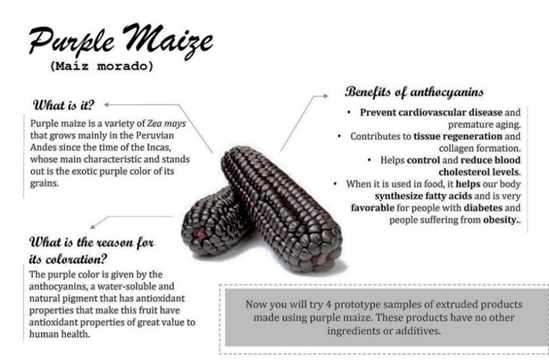
Figure 2 Informative sheet used to inform consumers on the general characteristics of Peruvian purple maize.
Table 1. Average acceptance scores of breakfast cereals

Samples are breakfast cereals formulated using PMF and YCG in ratios of 100:0, 75:25, 50:50, and 25:75. Values expressed as average ± standard deviations. Values within a row with different letters are significantly different through Tukey’s test (p < 0.05). ns = non-significant.
2.2.4. Stage 4: Market research
Additionally, market research was applied at the end of the test to evaluate consumers' expectations and desires for a product elaborated from purple maize if they found them on supermarket shelves. The participants answered seven questions with predetermined items: “What would you like added to this cereal in its final version?”, “What shape do you think the product should have?”, and “At what time of the day would you consume this product?”, “You would consume this product with...”, “Considering that this product may be healthier and bring health benefits, how much more would you be willing to pay? ”, “Would you find interesting a salty snack version. of this product? If yes, what flavor? ”, “Which of the following items do you think are/could be related to the product?”.
2.3. Data analysis
The data obtained from the acceptability test were evaluated using ANOVA, and when significant, at p < 0.05, Tukey’s test (SISVAR, version 5.6) was used to verify differences among the samples. To evaluate the results from the CATA, a Cochran Q test was applied to identify the terms that discriminated the samples at p ≤ 0.10. Selecting only the significant terms of the Cochran Q test, a correspondence analysis was conducted using the Hellinger distance. Then, principal coordinate and penalty-lift analyses were performed to investigate the association between the CATA terms and overall liking. These statistical analyses were carried out using XLSTAT software, version 2018.5 (ADDINSOFT, New York, USA). For market research, the results were presented as a frequency percentage.
3. Results and discussion
3.1. Acceptability test
No significant differences were observed between the scores given by the participants who tasted the cereal with or without milk, then Table 1 presents the general means without distinction between both groups. According to the results, all experiments obtained similar scores (p < 0.05) in aroma, flavor, and texture. The aroma and texture scores were above 5 points, translated in the hedonic scale, indicating that consumers neither liked nor disliked the cereals in terms of these characteristics. In particular, the texture scores were above 6 points, indicating that consumers slightly liked the texture of the breakfast cereals. The aroma and flavor results were expected since no aroma or flavor additives were added to the cereal formulation. Moreover, PM is a type of floury maize whose flavor and aroma commonly is described as subtle or delicate, so changes in its concentration may be imperceptible to consumers.
Differences in color and overall impression scores were observed between the experiments (Table 1). Breakfast cereals formulated with more than 50% PMF (50:50, 75:25, and 100:0) had scores close to 7 points, suggesting a tendency of moderate taste to the color of these cereals. While the experiment formulated with 25% PMF (25: 100) obtained a score below 5 points, placing it between I do not like, or dislike and I dislike slightly. Similarly, the overall impression scores of 50:50, 75:50, and 100:0 samples were higher than those of 25:75; however, in this case, the scores remained above 5 points, then there was no rejection.
The scores obtained could be directly related to the color intensity of the extrudates since while 50:50, 75:50, and 100:0 breakfast cereals had purple tones, 25:75 were closer to brown. These results coincide with those obtained in our previous study (Salvador-Reyes et al., 2023), where the instrumental color of cereals with more than 50% PMF was categorized as purple, while 25% PMF was categorized as brown. According to Lawless & Heymann (2010) and Zellner et al. (2018), more intense colors tend to have better acceptability because they are associated with an intense flavor and are more striking to the consumer. On the other hand, the purple color is related to PM anthocyanins, whose benefits were mentioned in the information sheet presented in the first stage of the analysis so this information may have influenced consumer acceptance. Jeong & Lee (2021) describe several examples showing that prior information on a food product's health benefits, cultural value, or sustainability can influence its acceptability by consumers. In this case, the purple color intensity in the samples may have been associated with greater bioactive compounds and healthiness. Further-more, PM is considered an exotic raw material in Brazil; consequently, it could have been associated with a more expensive or exclusive product.
Although the results of the acceptance test helped to know in a general way the consumers' affinity for the breakfast cereals, it does not allow us to know exactly what the specific characteristics or attributes are and to what extent these affected the scores awarded. Therefore, it was necessary to complement these results with a CATA test (Ares & Jaeger, 2013; Ares & Jaeger, 2015; Jaeger et al., 2020).
3.3. CATA
In the CATA analysis, where consumers were asked to mark all the terms related to the cereal samples related to appearance, color, aroma, flavor, and texture (Table 2).
According to Cochran's Q test, of the 35 attributes presented, only 18 were considered significant (p ≤ 0.10) to differentiate the breakfast cereal samples. Of the five groups evaluated, color and appearance terms were the ones that differentiated the samples the most. These results can be seen in Table 2, which shows the frequency (%) at which the CATA terms were used to describe the products, the p values of Cochran's Q test, and the multiple comparisons between the experiments.
Table 2 Frequency (%) with which the terms of CATA were used to describe the samples by consumers and Cochran’s Q sample comparison test
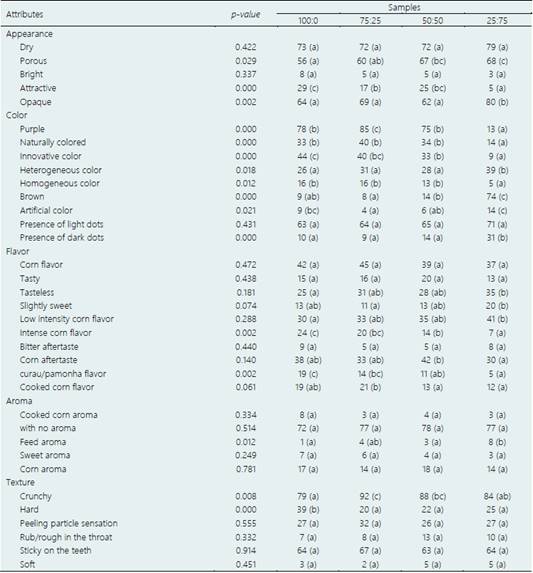
Samples are extruded breakfast cereals formulated using PMF and YCG in ratios of 100:0, 75:25, 50:50, and 25:75. The same letters in the same rows indicate significant difference at p≤0.10, according to Cochran’s Q test, the letter a is attributed to the lowest frequency, followed by b and c for increasing frequencies.
The most frequently used terms to describe the samples were dry, porous, opaque, with no aroma, presence of light dots, crunchy and sticky on the teeth, with a frequency above 60%. Amid these, the presence of light dots, with no aroma and sticky on the teeth terms showed no significant differences among the samples and were equally used to describe them. Although terms as attractive, purple, natural colored, innovative color, heterogeneous color, homogeneous color, brown, artificial color, presence of dark spots, slightly sweet, intense corn flavor, curau/pamonha flavor cooked corn flavor, feed aroma, and hard were associated with the samples at frequencies lower than 60%, these served to differentiate them. For example, 74% of consumers described the color of 25:75 as brown, while in 100:0, 75:25, and 50:50 extrudates this frequency was below 14%. The color of 100:0, 75:25, and 50:50 samples were highly associated with the terms purple (75%), naturally colorful (33%), and innovative (33%).
In this first part, it was observed that unlike the acceptability test, where the cereals only showed differences between the scores obtained in color and overall acceptance, in the CATA, the significant terms that served for differences in the experiments were related attributes of appearance, color, flavor, aroma, and texture. These results are more similar to those obtained in the techno-functional evaluation (Salvador-Reyes et al., 2023). In addition to the color, significant differences were observed in the samples' texture since the PFM concentration increased, their hardness decreased, but crispness increased. However, we highlight that the terms related to appearance and color served to the greatest extent to differentiate the samples, suggesting that these had a more significant impact or priority for consumers.
After analyzing the results of Cochran's Q test, the 18 significant CATA terms were selected to perform the correspondence analysis with the cereal samples. The Hellinger distance was used due to the presence of terms with low frequencies (Meyners et al., 2013).
According to the generated graph (Figure 3a), components F1 and F2 explained 97.8% of the data. In addition, it was possible to notice clear discrimination between 25:75 and the other three cereals (100:0, 75:25, and 50:50) mainly in the F1 component (91.85%), which included terms related to color, appearance, and flavor. While in F2 (5.95%), related to texture terms such as hard and crunchy, the discrimination between samples was lower. On the other hand, it is important to note that 50:50 had a position close to the origin, which would mean that it cannot be well explained in either F1 or F2.
In general, the discrimination of breakfast cereals was apparently based on products associated with the terms brown, presence of dark dots, opaque, porous, slightly sweet, heterogeneous color, artificial color, and feed aroma (25:75), and those associated with the terms innovative color, homogeneous color, intense corn taste, purple, naturally colored, curau/pamonha flavor, attractive (75:25 and 100:0). The terms linked with the samples can be related to the properties and components of the corn used and the proportion used. The PM anthocyanins are water-soluble, so they contribute to obtaining products with homogeneous and intense colors (depending on their concentration). Consumers related the samples with higher PM concentrations with the term natural color, which contrasts with the study of Dantec et al. (2022), where the colors most related to “natural” in foods by consumers were yellow, white, and green. Our observations may have been influenced by the information provided prior to the analysis; thus, the consumers must have related the cereal color with the natural color of PM grains.
An interesting fact was the association of the samples with the terms curau/pamonha and feed aroma, which was previously obtained through the focus group. Brazilian consumers described the flavor of the 75:25 and 100:0 samples as curaru/pamonha, which are typical Brazilian food made from cooked green corn with a delicate aroma. On the other hand, the 25:75 sample was described several times as a feed aroma, which may be related to the fact that a large part of the animal feed is formulated using YCG. This aroma is masked using artificial flavorings in the food industry (Bhattacharya, 2023), suggesting that PM could be a better alternative for foods without additives or clean labels.
When making the association of the terms and the scores obtained in the test of acceptability (liking) through a PCoA (Figure 3b), it was possible to observe how the terms attractive, crunch, purple, naturally colored, and innovative colored were located in a radius close to liking so that they can be considered as positive terms. On the other hand, the terms hard, brown, opaque, and porous can be considered negative. Subsequently, these results were supported by the penalty-lift analysis represented in Figures 4a and 4b.
The measurement of the mean impact in the penalty-lift analysis (Figure 4a) revealed that the most important drivers of liking were attractive, crunchy, purple, naturally colored, and innovative color, which is related to appearance and color. These attributes had a positive impact greater than 0.5 points on the general acceptability of breakfast cereals, so they may be considered “must-haves” in developing a new product. In addition to the impact on the averages, the frequency with which these were associated with the samples by consumers was also considered. In this sense, when analyzing the mean impact vs % frequency (Figure 4b), it was observed that the term attractive, despite having the greatest impact on the mean acceptability of the samples (1,317 points), was only used by 19% of consumers to describe them. Whereas the term crunchy, in addition to raising acceptance by 1,158 points, was used by 85% of the consumers to describe the samples, it can be considered one of the most important characteristics of breakfast cereals.
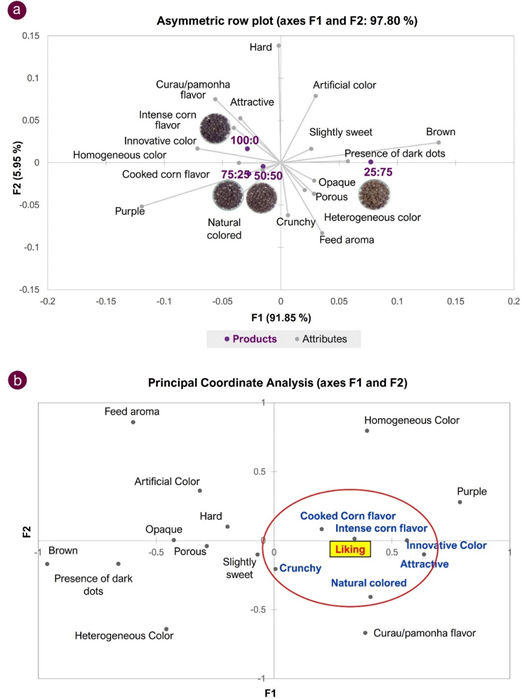
Figure 3 a) Correspondence analysis (CA) using Hellinger distance, b) Representation of the first and second dimensions of the Principal Coordinate Analysis (PCoA), showing the CATA terms and overall liking.
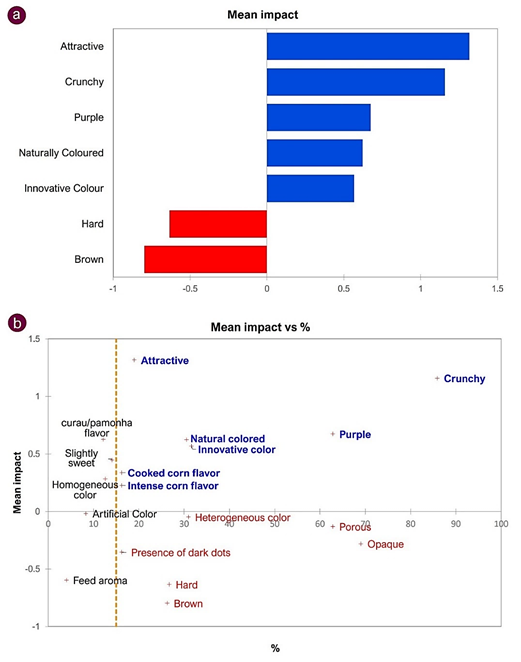
Figure 4 Penalty-lift analysis: a) terms with highest positive (blue) or negative (red) mean impact, used by more than 15% of consumers, b) Mean impact vs answers (%). Attributes situated in the lower part of the graphic are negative.
Considering these results, it can be deduced that although the appearance and color of the cereals are attributes that impacted the participants, the texture of the cereal played the main role during the evaluation. These findings coincide with what was stated by Andersen et al. (2019) and Santagiuliana et al. (2019), who observed that beyond the striking or novel appearance of the food, the acceptance scores, and general taste depend on its flavor and texture. According to Leusner (2020), breakfast cereals are expected to be crunchy and remain so when mixed with milk. According to our previous studies, the crispness of cereals with PM may be related to PMF fibers, granulometry and the floury starch of their endosperm (Salvador-Reyes et al., 2021), which makes it softer and more brittle than YCG, moreover once immersed in milk, PM cereals can stay crispy for longer time than YCG (Salvador-Reyes et al., 2023). Navarro-Cortez et al. (2018) had similar results in the acceptance test of extruded cereals formulated using Mexican blue corn.
The attributes that negatively impacted the accep-tance scores of the samples belonged to the categories of appearance, texture, and color. Those with the greatest impact were hard and brown, decreasing the acceptability of cereals by 0.634 and 0.798 points (Figure 4a), respectively. However, the frequency with which these were associated with the samples was less than 30% (Figure 4b). On the other hand, although the terms porous and opaque had a lower impact on the score of the samples, they were used 63% and 69%, respectively, to describe the samples for what they can consider attributes or characteristics that should be improved and avoided during cereal production.
3.3. Market research
Market analysis was performed to determine the expectations and suggestions of Brazilian consumers for the future development of a more commercial version of a cereal formulated with PM (Figure 5).
It was observed that 44.4% (52) of consumers recommended adding nuts (chestnuts, peanuts, or almonds) to the final version of the product to maintain its healthy characteristics; also 38% (44) of them also suggested that it would be good to add honey coverage since the product lacks sweetness. These data reaffirm the interest of consumers in more natural and healthy products. Previous studies, Lähteenmäki (2013) and Prada et al. (2021) indicate that consumers have been opting for alternatives with low concentrations of added sugar since this ingredient is related to some chronic diseases. For the format, 66% (77) of consumers indicated that they prefer the cereal in a ball shape, and 35% (41) indicated that the commercial format as corn flakes would be an interesting alternative since the product would be crispier. The preference for cereals in the ball shapes may be related to the commercial references of the Brazilian breakfast ce real market since most of the national cereals have this shape.
Regarding the time of day, 90% (105) of the consumers indicated that it would be good to eat this cereal during breakfast, and 35% (41) and 32% (38) also indicated that afternoon meal and snack options are viable, respectively. Among the preferred accompaniment options, milk and yogurt were chosen by 77% (91) and 70% (90) of consumers, respectively. It is also important to note that 48% (56) of the responses suggest their pure consumption. These observations are relevant because they suggest that the extruded cereals of PM could also be marketed as a healthy snack that can be consumed pure or with accompaniments at any time of the day, be included in the school lunch box, no limiting its consumption just for breakfast. In addition, when asked if consumers thought it was possible to have a salted version of this product, 73% of them accepted the idea, of which 61% (52) chose the "Olive and herbal" flavor, and 41% (34) and 37% (31) preferred “tomato and basil” and “Lemon pepper” flavors, respectively. Other flavors recommended were "barbecue, cheese, bacon, onion, and parsley", which opens the possibility of the use of these extruded cereals in the development of salty snacks that can compete with the fried expanded ones on the market as a healthier option (without oil and salt), nutritive (with fibers) and natural.
Considering that this cereal was elaborated using whole flour of Andean purple maize, an exotic raw material that could offer health benefits, 43% (50) of the consumers affirmed that they would pay up to 15% more than the values of the common commercial cereals, and 41% (48) of them mentioned that would pay up to 30% more. These observations coincide with Apaolaza et al. (2017), Kunz et al. (2020), Zorbas et al. (2018), in whose studies it is evident that consumers are willing to pay more for products that have a healthier appeal, whose consumption brings some benefit to health and contain exotic ingredients with new flavors. Bearing in mind that in local Brazilian markets, the prices of breakfast cereals elaborated with whole flour and organic grains are at an average of 12 to 14 reals per 300 g, this cereal could be marketed at a price between 15 to 17 reals and would have a public potential to acquire it.
4. Conclusions
The breakfast cereals formulated with purple maize flour had good acceptability by Brazilian consumers, considering that they were prototypes without final format, color or flavor additives. Providing informative material on the origin of the raw material used and its possible health benefits before the analysis allowed us to positively affect consumers' perception of a product made with a foreign raw material such as PM. The application of acceptability tests followed by CATA questions allowed a better understanding of the consumers' perception of the sensory characteristics of new products associated with health, functional and clean label claims. It is interesting to highlight that color and texture aspects were the most important for product discrimination and had a high impact on liking. The CATA terms attractive, crunchy, purple, naturally colored, and innovative color were drivers of liking, while hard and brown had a negative effect. Brazilian consumers associated the taste of purple maize cereal with known flavors within the regional cuisine, demonstrating their predisposition to accept new flavors. On the other hand, market research could provide a perspective on how consumers would like to find this product, opening several possibilities for product development, including salty versions.
In this way, purple maize is an interesting and promising ingredient to produce extruded cereal products within the Brazilian market as a source of fiber and bioactive compounds, positively modify ing its sensory characteristics, mainly by adding an appealing purple color to the final product. This ingredient opens opportunities for developing different, healthy, and innovative products, with high added value, in different areas of the food sector, contributing to consumer demand for sustainable and nutritious food with new flavors and unique sensory characteristics.














